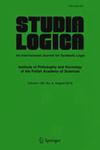安格尔和麦考尔会见万辛
IF 0.6
3区 数学
Q2 LOGIC
引用次数: 0
摘要
在本文中,我们介绍了一种新的逻辑,称之为 AM3。它是一种具有几个有趣性质的连通逻辑,其中包括强连通性和验证了匡衡波爱修斯定理。这两个特性是安格尔和麦考尔的 CC1 与万辛的 C 之间的区别。我们将证明,在其他方面,AM3 也结合了 CC1 和 C 的优点。然而,一些问题依然存在,我们最后指出了AM3中的一大批弱逻辑,并邀请我们进一步探讨。本文章由计算机程序翻译,如有差异,请以英文原文为准。
Angell and McCall Meet Wansing
In this paper, we introduce a new logic, which we call AM3. It is a connexive logic that has several interesting properties, among them being strongly connexive and validating the Converse Boethius Thesis. These two properties are rather characteristic of the difference between, on the one hand, Angell and McCall’s CC1 and, on the other, Wansing’s C. We will show that in other aspects, as well, AM3 combines what are, arguably, the strengths of both CC1 and C. It also allows us an interesting look at how connexivity and the intuitionistic understanding of negation relate to each other. However, some problems remain, and we end by pointing to a large family of weaker logics that AM3 invites us to further explore.
求助全文
通过发布文献求助,成功后即可免费获取论文全文。
去求助
来源期刊

Studia Logica
MATHEMATICS-LOGIC
CiteScore
1.70
自引率
14.30%
发文量
43
审稿时长
6-12 weeks
期刊介绍:
The leading idea of Lvov-Warsaw School of Logic, Philosophy and Mathematics was to investigate philosophical problems by means of rigorous methods of mathematics. Evidence of the great success the School experienced is the fact that it has become generally recognized as Polish Style Logic. Today Polish Style Logic is no longer exclusively a Polish speciality. It is represented by numerous logicians, mathematicians and philosophers from research centers all over the world.
 求助内容:
求助内容: 应助结果提醒方式:
应助结果提醒方式:


